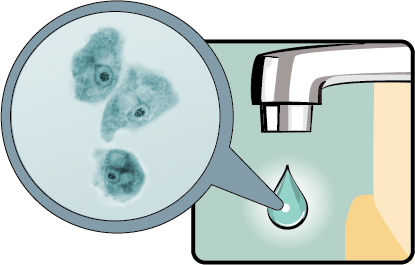Ritual Nasal Rinsing & Ablution
Print-and-Go Fact Sheet
Many tiny germs live in warm water. Naegleria fowleri is a water-loving ameba (very small germ) that is often found around the world in ponds, lakes, and rivers 1, 2. It also can hide in pipes connected to tap water 3-6.
Naegleria is so small, even water that looks, smells, and tastes clean can have the amebae swimming in it. Nasal rinsing with unsafe water can lead to infection 3-6.
Infections from Naegleria are deadly and rare.

Many people perform ritual nasal rinsing. This practice is included in Yogic, Ayurvedic, and Islamic traditions. Within the Islamic faith, ritual nasal rinsing is included in a cleansing process called “wudu” or “ablution.” It is usually performed several times a day in preparation for prayer.
When water tainted with Naegleria is sniffed up the nose, the ameba can travel to the brain 1-3. This causes the disease primary amebic meningoencephalitis (PAM), which destroys brain tissue and usually results in death 4, 5.
-
Infections are deadly: Of 143 people known to be infected in the United States from 1962—2016, only four people have survived 4.
- Most Naegleria infections are due to swimming in warm lakes or rivers.
- Infections are rare: There has only been one reported Naegleria infection associated with ritual nasal rinsing in the U.S. 2
References
- Yoder JS, Straif-Bourgeois S, Roy SL, Moore TA, Visvesvara GS, Ratard RC, Hill VR, Wilson JD, Linscott AJ, Crager R, Kozak NA, Sriram R, Narayanan J, Mull B, Kahler AM, Schneeberger C, da Silva AJ, Poudel M, Baumgarten KL, Xiao L, Beach MJ. Primary amebic meningoencephalitis deaths associated with sinus irrigation using contaminated tap water. Clin Infect Dis. 2012;55(9):e79-85.
- CDC. Primary amebic meningoencephalitis associated with ritual nasal rinsing — St. Thomas, U.S. Virgin Islands, 2012. MMWR Morb Mortal Wkly Rep. 2013;62(45):903.
- Shakoor S, Beg MA, Mahmood SF, Bandea R, Sriram R, Noman F, Ali F, Visvesvara GS, Zafar A. Primary amebic meningoencephalitis caused by Naegleria fowleri, Karachi, Pakistan. Emerg Infect Dis. 2011;17(2):258-61.
- Yoder JS, Eddy BA, Visvesvara GS, Capewell L, Beach MJ. The epidemiology of primary amoebic meningoencephalitis in the USA, 1962-2008. Epidemiol Infect. 2010;138(7):968-75.
- Visvesvara GS. Free-living amebae as opportunistic agents of human disease. J Neuroparasitol. 2010;1.
Use safe water to protect yourself.

This image shows Naegleria about 1,000 times bigger than it really is.
Take at least one of these actions to lower your risk of becoming infected with Naegleria during ritual nasal rinsing:
-
Boil: Use water that has been previously boiled for 1 minute and left to cool.
- At elevations above 6,500 feet, boil for 3 minutes.
-
Filter: Use a filter designed to remove some water-loving germs.
- The label may read “NSF 53” or “NSF 58.”
- Filter labels that read “absolute pore size of 1 micron or smaller” are also effective.
- Buy: Use water with a label specifying that it contains distilled or sterile water.
-
Disinfect: Learn how to disinfect your water to ensure it is safe from Naegleria.
- Chlorine bleach used at the right level and time will work as a disinfectant against this germ.
You cannot get infected from drinking tainted water. You can only get PAM when contaminated water goes up into your nose.
Talk to your doctor if you have concerns.
Naegleria infection may be mild at first and include headache, fever, nausea, or vomiting. Later symptoms may include stiff neck, confusion, seizures, and hallucinations 1. The disease generally causes death within about 5 days after symptoms start 2.
References
- Visvesvara GS. Free-living amebae as opportunistic agents of human disease. J Neuroparasitol. 2010;1.
- Yoder JS, Eddy BA, Visvesvara GS, Capewell L, Beach MJ. The epidemiology of primary amoebic meningoencephalitis in the USA, 1962-2008. Epidemiol Infect. 2010;138(7):968-75.
References
- Yoder JS, Eddy BA, Visvesvara GS, Capewell L, Beach MJ. The epidemiology of primary amoebic meningoencephalitis in the USA, 1962-2008. Epidemiol Infect. 2010;138(7):968-75.
- Visvesvara GS. Free-living amebae as opportunistic agents of human disease. J Neuroparasitol. 2010;1.
- Dorsch MM, Cameron AS, Robinson BS. The epidemiology and control of primary amoebic meningoencephalitis with particular reference to South Australia. Trans R Soc Trop Med Hyg. 1983;77(3):372-7.
- Yoder JS, Straif-Bourgeois S, Roy SL, Moore TA, Visvesvara GS, Ratard RC, Hill VR, Wilson JD, Linscott AJ, Crager R, Kozak NA, Sriram R, Narayanan J, Mull B, Kahler AM, Schneeberger C, da Silva AJ, Poudel M, Baumgarten KL, Xiao L, Beach MJ. Primary amebic meningoencephalitis deaths associated with sinus irrigation using contaminated tap water. Clin Infect Dis. 2012;55(9):e79-85.
- CDC. Primary amebic meningoencephalitis associated with ritual nasal rinsing — St. Thomas, U.S. Virgin Islands, 2012. MMWR Morb Mortal Wkly Rep. 2013;62(45):903.
- Shakoor S, Beg MA, Mahmood SF, Bandea R, Sriram R, Noman F, Ali F, Visvesvara GS, Zafar A. Primary amebic meningoencephalitis caused by Naegleria fowleri, Karachi, Pakistan. Emerg Infect Dis. 2011;17(2):258-61.
- Pellerin J, Edmond MB. Infections associated with religious rituals. Int J Infect Dis. 2013;17(11):e945-8.
- Page last reviewed: February 28, 2017
- Page last updated: February 28, 2017
- Content source:


 ShareCompartir
ShareCompartir
 Safe Ritual Nasal Rinsing
Safe Ritual Nasal Rinsing